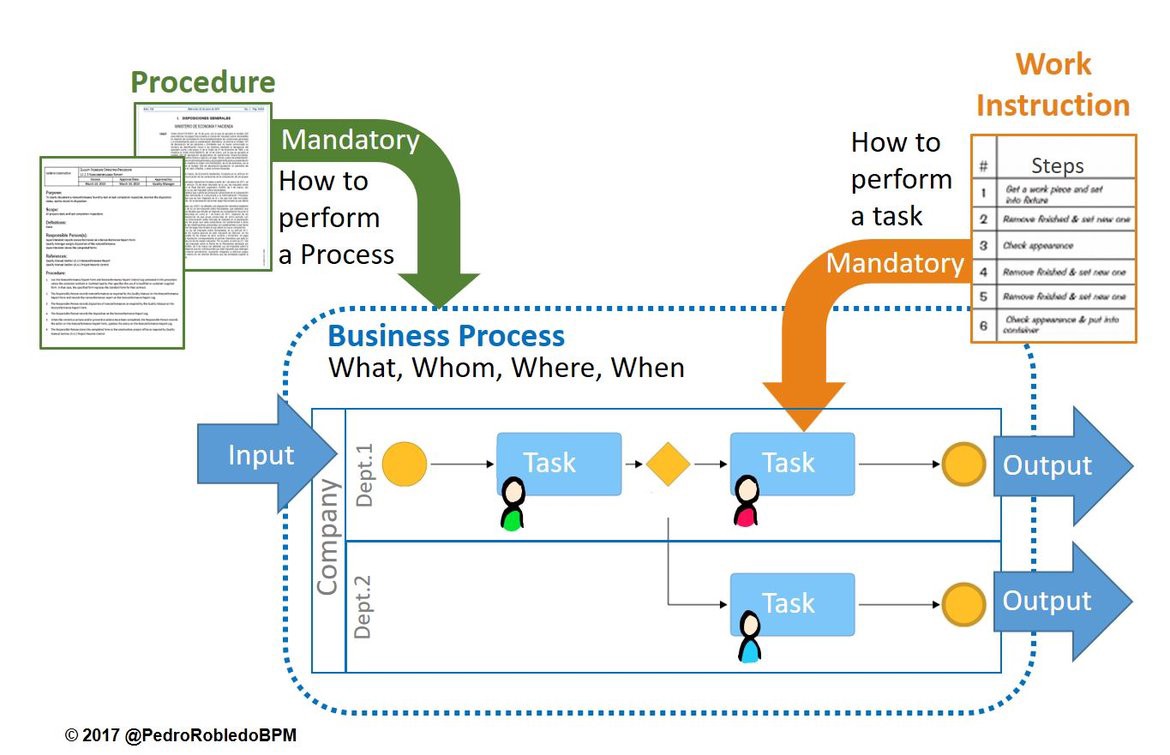 Procedure vs. Process vs. Work Instruction
Procedure vs. Process vs. Work Instruction
Many people often confuse these three terms: business Process, Procedure, and Work Instruction. In fact, most people write work instructions and call them procedures, and define a procedure as a process. My objective in this paper is to provide the difference amongst the three terms to help you understand when to use each term in the Quality Management of your Business.
The ISO 9001:2015 standard (Quality management systems ? Fundamentals and vocabulary) defines the concept of Business Process as: ?A set of related or interacting activities, which transform inputs into outputs?. It is possible to qualify something more by saying that a process is a sequence of activities with a realization order in time, which converts a given input into an output (result, a product). Any activity, or set of activities, that uses resources to transform input elements into results can be considered as a process.
Business Processes are modeled on the Business Process Model and Notation (BPMN) standard, reflecting the start of the process, the responsibilities of the activities, the sequence flows with all possible paths (to collect all the exceptions through decision points), the activities to be carried out, the roles that execute each activity, the events that occur in the process and the finalization (one or several end events) of the process.
Do not confuse procedure with process. The ISO 9001: 2015 says that a Procedure is: ?specified way to carry out an activity or a process?. When you have a process that must happen in a specific way, and you specify how it happens, you have a procedure. The procedure is mandatoryand is necessary to develop any Quality Management System. Please pay your attention that not all processes need to have a procedure, and that the same process may have associated one or several procedures.
A procedure will be determined by the need to detail the specific way of doing the activities by legal issues, regulatory compliance or company policies. The procedures are used for those activities in which several operations are linked and different people or departments of the company are involved (for example, Procedure for the presentation of Fiscal Models in the Treasury, Purchasing Procedure, Supplier Evaluation Procedure, Automation Procedure of Invoices, Procedure for Risk Work?).
Work Instructions are documents that clearly and precisely describe the correct way to perform certain tasks that may cause inconvenience or damage if not done in the established manner. That is, describe, dictate or stipulate the steps that must be followed to correctly perform any specific activity or work. For example, Document of the Purchasing Area that describes the Accreditation Documentation of the Expense to be presented by the Employee in his Expense Note and the steps to proceed to present his monthly expenses; this work instruction would be linked to the ?Submit Expense Note? Activity.
The work instructions are mainly focused on explaining how a specific activity is going to be carried out, and they are mandatory. The work instructions are used to describe a specific operation, usually associated with a job. If they are not mandatory, we would be talking about a Work Guide.
Main Differences between Process, Procedure and Work Instruction
DIFFERENCES REGARDING QUALITY MANAGEMENT
BPM helps execute business processes to achieve compliance with the Quality Management System so that the organization keeps all the documented information (mandatory records) for ISO quality audits.
A procedure is usually described in a Word document, but could include the complete diagram in BPMN that explains at a high level the different activities to be performed. The ISO 9001 standard requires documented procedures for effective planning, operation and control of the processes within the quality management system of a company, which will include the documented information necessary to support the operation of the processes.
The work instructions are optional for a system based on ISO 9001, but are generally included for consistent operations. The instructions are written to give instructions in a logical work sequence.
CONCLUSION
The BPMN Business Process will be supported if necessary by procedures for mandatory legislative or regulatory compliance or company policies. And it will be supported by work instructions to document the obligatory steps to follow in those activities that require it.
